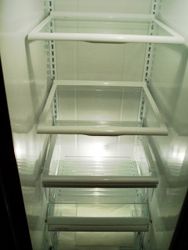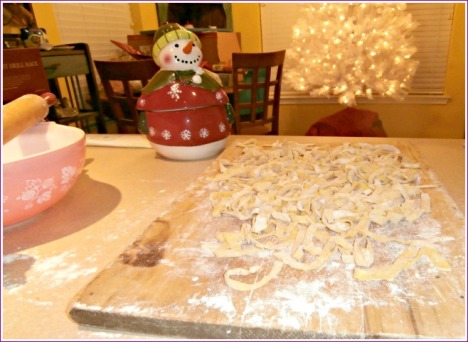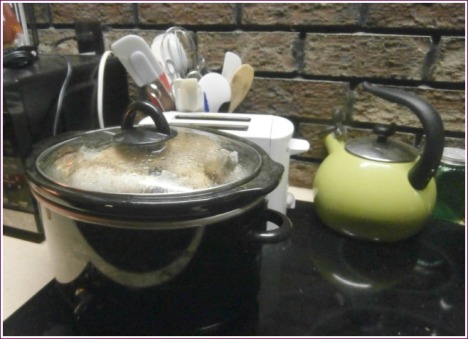This week really felt good–getting back to a normal schedule, after being at loose ends without electricity and not working. I feel so fortunate to have pretty much everything back to normal, when there are so many who don’t, from those still without electricity here around town, to those down on the coast and other places inland, who lost so much–homes, jobs, and, in some cases, even loved ones.

A Clean Fridge
It’s actually nice to start with a clean, fresh refrigerator. I threw everything out the next day after Hurricane Ike came through, knowing that even though the fridge was still cool, the electricity probably wasn’t going to come back on soon enough to save anything, and, in fact, it didn’t.
Somehow restocking the fridge and just going through being without utilities for a few days got me to thinking about the blizzards that we used to have on the farm when I was a kid. If there was an ice storm, or the winds were strong enough and snapped a pole, then there’d be no electricity. And the electric crews couldn’t get out to repair the lines until the snow plows opened up the drifted roads.
The worst storm I remember was when I was in maybe second or third grade. The drifts in front of the house were lots taller than Dad, and some of the drifts on the roads covered them completely, so it was hard to know where the roads and ditches were or where the stone post and barbed wire fences were alongside them. That year, the National Guard flew out in helicopters or airplanes and tried to throw hay bales down for the herds of cattle that were stranded out in the snow. Apparently, they missed their target somewhere between our place and town, because they ended up tossing some of the bales down onto some power lines, and made getting the electricity back on much more of a problem. It took two weeks to get electricity back and for the snow plow to come make a way for us to get out.
During the time the lights were out, the biggest problem on our farm was getting water because there was an electric pump on the well. There was a tank in the well, but even if there was electricity, sometimes the pipe from the well to the house would freeze up. If it didn’t freeze, we’d try to make the water from the tank stretch, just using it for drinking. For washing, we’d go out and get snow to melt or go to the creek, break the ice on top, and bring it back, then strain it with the milk strainer to get it clean enough to use.
A lot different than these “modern” days, when a hurricane comes through during the hot months, keeping food and cooking it was never really a big problem when the electricity went off during a blizzard. Things from the fridge that needed to stay cold could go out in the wash house, where they would stay really cold or even frozen. Also Mom always kept cupboards stocked with the basics like flour and lard, and there was milk and cream from the couple of milk cows that we usually had, which needed to be milked blizzard or no blizzard. We also used propane for the cook stove and heating, so we always kept warm and ate well. Out back, we had “the cave”, which held the jars of canned vegetables and fruits and a bin filled with potatoes. (The cave is another story altogether.)
Mom cooked a lot on cold days because it warmed up the kitchen, which helped keep the entire house warmer. It seems like we always had a lot of soups on those cold winter days. Because we had chickens, we had homemade noodle soup and from our own meat, vegetable beef soup, and, well, chili too. Mom made the best angel food cakes, and I usually got a chocolate angel food cake for my birthday. (You’re thinking I’m changing the subject, but I’m not.) The angel food cake Mom made took a dozen egg whites, so then the yolks were left over–Just what is needed to make homemade noodles. Mom would roll them out on the linoleum-topped kitchen table into big round circles, and then hang them over the backs of the chairs to dry a bit. Then she’d lay all of them one on top of the other, roll them up, and slice them into thin, curly strips, spreading them out on the table to dry some more. That’s when we’d try to sneak a few of the fresh, uncooked noodles without her seeing us. Well, I did that; being the youngest, I know I did. And I got away with it most of the time.
We had our own meat from the cows we raised. Dad would get somebody to take one of the younger ones that had been born the spring before into Klema’s in Wilson, where it would be butchered. Klema’s also had a locker plant, which rented lockers where you could keep the meat that had been butchered frozen. I’d go back in there with Dad when we went to get groceries; it was so cold that they had extra coats hanging on some hooks that you could wear while you were inside the locker part. Dad had his own key for our locker, which he opened and got the meat that we wanted for that week. There was no cellophane or styrofoam on those packages of meat; everything was wrapped in white butcher paper, taped closed, and stamped with whatever cut of meat was in the package: Pike’s Peak roast, round steak, hamburger, and the like.
From our own ground beef, one of the best cold weather dishes that Mom made was bierochs (pronounced beer-rocks). (Actually, now that I’m writing this I’m thinking that I’m going to make some when the first really cool weekend arrives here in Houston. But who knows when that will be?) Not many people are familiar with beirochs unless they’ve got some German-Russian in their heritage. And I don’t mean German or Russian, I mean German-Russian. In the area of Kansas where I grew up there were lots of people whose heritage is German-Russian. I don’t know the history of it all because our family was not of that descent, but apparently, for reasons of not wanting to be in one military or another military, at some point, large numbers of these people immigrated from Germany to somewhere near the Volga River in Russia, and then in the late 1800s and very early 1900s, many of them or perhaps their descendants immigrated to the US, especially to parts of central and western Kansas.
And one of the best things they brought with them was bierocks. It was one of those dishes that many people in my little town of Dorrance made (and still make), and my mom was one of them. I guess she may have learned how from an aunt. We didn’t have bierochs too often at home because they’re one of those delicious dishes that take time to make. Basically, they are a meat and cabbage filled bun. The filling is the easy part, and it doesn’t take exact measurements. How much of the few ingredients you use depends on how many bierochs you want to make.
In a big skillet, you need to brown up some ground beef (a pound or two) and some onion, just like you might do if you were making spaghetti sauce. Then drain off any grease that cooks out. Then add at least a half of head of shredded cabbage. Again, you might want more cabbage if you’ve used more ground meat. (My mom used to complain that some other women were cheap and didn’t use enough, or maybe any meat.) Salt and pepper well because the cabbage, especially, will absorb the seasonings. (I’ve lived in Texas so many years that sometimes I also add about a quarter teaspoon of cayenne pepper.) Put a lid on the meat and cabbage mixture and let the cabbage cook down some. The cabbage can stay a tad on the not-so-cooked side because this filling will cook a bit more when baking the bierochs themselves. When cooked, let the mixture cool down some before filling the dough. I’ve seen some recipes that add ketchup and mustard and a few other ingredients, but ground beef, cabbage, a little onion, and salt and pepper is “the Dorrance way”.
To make bierochs quickly, some people like to roll out dinner rolls from the dairy case to use for the outside. I’ve tried that, but the results are just “OK”. You really need a good recipe for homemade rolls, or “buns” as we’ve always called them, for the bread covering of the bierochs, if you’re going to make “real” bierochs. As I said before, the filling is the easy part, so if you’re going to make homemade dough, you have start it first. And if you’re going to have bierochs for supper, you might want to get the dough started in the morning, depending on how fast your dough rises. Making bierochs really is not difficult, but because there are several steps, it does take time.
Here is my mom’s “bun” recipe, but I’ve also used one that included a mashed boiled potato and the potato water. Both are good.
1/4 cup warm water, 1 package yeast, 1/2 cup sugar, 1 1/2 teaspoons salt, 3 tablespoons shortening, 2 beaten eggs, 2 cups boiling water, and 7 cups flour
Dissolve yeast in the 1/4 cup of water. (Add a teaspoon of sugar to make the yeast rise.) Put sugar, salt, and shortening in a large glass or crock bowl. Add 2 cups of boiling water, and let cool. Add beaten eggs, yeast, and four cups of the flour. Beat well (with an electric mixer). Then add the rest of the flour and stir in gradually. Let rise until doubled.
For bierochs, take a portion of the dough and roll it out on a flour-covered surface until it is about 1/4 (or less) inch thick. Cut the dough into pieces about six inches square. You’ll probably need to roll each piece again as it tends to pull back together once you cut it. Using a spoon, heap about 1/4 cup of the filling into the center of the square of dough. Then fold the corners in so that all 4 corners meet; pinch all of the seams tightly closed. Then place the bierock in a greased baking pan, seam side down. Continue making the individual bierocks and arranging them in rows in the baking pan. The bierocks do not need to touch in the pan because they need to rise one more time before baking. Place a tea towel over the entire pan (or pans depending how many you have made) and let rise until they look like soft pillows. Preheat the oven to 375 degrees. Bake the bierochs until they are golden brown on top. (If you have made more dough than filling, you can make the rest of the dough into “buns”. With your hands greased, roll the dough into balls a bit larger than a silver dollar, place them in a greases baking pan, let rise, and then bake at 375 degrees for 25 minutes.)
Some people like to make much bigger bierochs, maybe because they think they can make them faster, but I like them about the size of a hamburger bun (only square). Plan for two or three per person. These are great with a nice salad or vegetables alongside. Some people (including me) like to dip bierochs in a little ketchup; however, some people are purists and like them plain. They are great right out of the oven, but they can also be kept in the refrigerator and heated up in the microwave. They also freeze well if they are kept in a very tight plastic bag or container.
Still today, after eating foods from all over the world, if someone asks me what my favorite is, I’ll still say the same thing that I would have said when I was about 10 years old: bierochs.
________________________________________________________________________________________________
If you liked this article, you might like Hamburger Gravy, Puddin’ Meat, Coffee Milk and Hopalong Cassidy, and Sex in a Pan.
Filed under: Annie and Dog Talk, It's What I Like, Maps, Geography, and Places, Talking About Food, The VW Bug Chronicles | Tagged: angel food cake, bieroch recipe, bierochs, blizzard, Buns, cabbage, dorrance, German Russian immigrants, ground beef, homemade noodles, Houston, Hurricane Ike, Kansas, Kansas foods, Kansas history, Klema's IGA, locker plant, milk cows, National Guard, no electricity, power lines, propane, Rolls, snow plows, Wilson Kansas | Leave a comment »






 http://jointheimpact.com
http://jointheimpact.com


